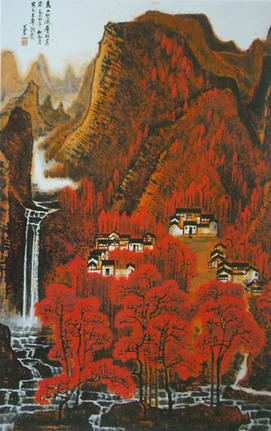|
The landscape painting embodies typical Chinese views on nature and life. Pursuing "harmony between man and nature," people in ancient times believed that humanity is part of nature. This idea was first formed about 2,500 years ago. In the late Spring and Autumn Period (770-476 BC), Li Er, or Lao Zi as he was known by later generations, advocated retirement from public life to the countryside to achieve a simple and happy existence. As one of the greatest philosophers in ancient China, he enjoyed equal popularity with Confucius. Getting tired of the pressure brought by work and fame, people are likely to turn to Lao Zi's maxim – give up all striving for gain, and go back to nature. For many Chinese, the landscape painting represents an idyllic life, free from worldly concerns.
Lao Zi's doctrines evolved into Daoism, a religion of the late Eastern Han (AD 25-220). Its followers believed they could become immortal if they lived a simple life and diligently practiced in remote mountains. From that time on, imposing mountains, pines and cypress, waterfalls and creeks were commonly depicted in landscape paintings, and regarded as representations of a fairyland.
In the Song Dynasty, landscape artist Guo Xi (AD 1000-1090) even put forward a standard for this landscape fairyland – a good painting should give viewers the feeling that they can walk, live and travel in it.
Darlings of the Auction
|
 |
|
Ten Thousand Hills Crimsoned Through by Li Keran. |
The value of these paintings is quite real. In July 2006, Fu Baoshi's Ode to Rainflower Terrace was auctioned for RMB 46.2 million, a record price for contemporary landscape paintings.
About ten months later, Li Keran (1907-1989)'s work Ten Thousand Hills Crimsoned Through became a magnet at Hong Kong Christie's. After rounds of bidding, it was sold for HK $35.04 million. From 1962 to 1964, Li created seven landscapes inspired by Chairman Mao's famous line "I see a thousand hills crimsoned through, by their serried woods deep-dyed," and this painting is the largest of the seven at 131 cm by 84 cm. Li painted with high-quality vermilion obtained from the stocks of the former royal family. With red as the basic color, the landscape merges hues that suggest joy as well as tranquility. This exquisite masterpiece fully reflects his formidable skills.
As a living icon of Chinese art, Li always deprecated himself with the title "swot" – a student who sweats, or must apply himself ardently to his subject. He believed the process of learning landscape painting was a steep challenge and that only the persistent achieved success. At an early age, Li received a comprehensive education in Western art. Then he started to learn from renowned Chinese painting masters, like Huang Binhong (1865-1955) and Qi Baishi (1864-1957), trying to integrate the Western artistic practice with Chinese traditions. With such disparity between the two schools, it was only wisdom and courage that helped painters find a balance. But Li finally succeeded and created a unique style of his own.
The final touch to any painting is the application of a seal or seals. Painters used to carve their names, artistic propositions or aphorisms on precious stones. In the 1950s, Li loved to use two seals – "Courage is valuable" and "In pursuit of the soul." He explained later that it was courage that let painters break from set patterns, and the soul that embodies the spirit of an age. Believing all beautiful scenes of the motherland should be admired, he was determined to capture the richest content on paper. Li applied the Western sketching method to render shadows on mountains, and also pioneered the backlighting method. So his paintings of heavy black mountains do not lower the viewer's spirit; you can always spot rays of light outlining the stone faces, as well as waterfalls and houses nestled in deep forest. His style went mainstream in the last two decades of the 20th century. |
